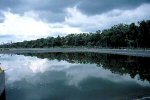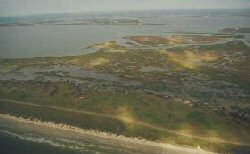WETLANDS: A practical view of systems
Jerry L. Cooke, Ph.D., Management Analyst, Coastal Fisheries Division
“Sometimes you can observe a lot, just by looking.” Yogi Berra
The term “ecosystem” was coined by an Englishman, Sir Arthur George Tansley (1935), and he postulated that it was a process or series of processes through which energy flowed and within which nutrients cycled. Now, 68 years, later, research has proven that an ecosystem is…well…a process or series of processes through which energy flows and within which nutrients cycle. A wetland is a kind of ecosystem that is loved and hated, lauded and scorned, and finally protected, in many instances, by law.
The following is a very general discussion about wetlands aimed at offering new ways to think about them. I’m a practical ecologist. I believe in simple definitions for simple notions such as: Good management makes you money; and bad management costs you money. I know that sounds just a bit on the obvious side, but it is an idea not often associated with wetlands and it should be. Or, an “economy” is a process or series of processes through which wealth flows and within which currency cycles (sounds similar to wetlands?).

In most areas of commerce, the producer doesn’t determine the price of his/her product, the market does. About the only thing that the producer has control of is the cost of production. So what is the analogy with wetlands? For a natural system, there is the cost of creating ($0), improving ($0), maintaining ($0), and, of course, harvesting (fill in your own gathering effort here). For normal commerce, there is the cost of creating (this is often the cost of removing the natural system and establishing something new), improving (changing the natural state), maintaining (the cost of keeping the natural system from recovering) and, of course, harvesting (fill in your own gathering effort here). Basically, the closer an operation is to a natural system, the lower the cost of production and the less vulnerable the operation is to market changes.
At this point you may be thinking, “Wetlands, wetlands, I thought he was going to talk about wetlands…” Okay, one of the more important discoveries in systems or landscape ecology was the idea of sources, where animals come from, and sinks, where animals live. The really important part of this discovery was that the same physical locations on the landscape are both the sources and sinks for almost all species of animals and -- the most stable and predictable sources/sinks are wetlands!

A wetland is land that is wet enough, for enough of the year, to eliminate plants that cannot survive being at least partially submerged much of the time. (So, in practice, a wetland designation may seem an arbitrary one, but it is one that the natural system designates rather than the “government.”) More specifically, how water arrives and is used creates three different kinds of wetlands in Texas: Swamps (these have a continuous, one directional flow channel through them like a river - rare), marshes (these catch run-off, tidal washes, or both – common/important), and bogs (these are marshes where plants germinate and grow more quickly than dead or dying plants can decay - rare).

Whether you are a duck hunter or a saltwater fisherman, you have a vested interest in coastal marshes or wetlands. The majority of waterfowl harvested in the central United States by hunters are taken in Texas - and the majority of those are taken along the Texas coast because of coastal wetlands and healthy bays. On the other hand, many saltwater species sought by fishermen (including redfish, trout, flounder, shrimp, etc.) exist because they “grow up” in coastal wetlands. As it turns out, those two uses (ducks and fish) are not mutually exclusive. Plus, there are also many other potential uses of these wetlands that can occur compatibly so long as all concurrent uses are considered in planning for each new potential use. But therein lies the potential for conflict because “sharing toys (resources in this case)” is not necessarily a natural trait.

Now, water planning has arrived in Texas – a really big experiment in sharing. You can participate in it or you can ignore it and go with the flow. However, the reality is that growing human populations will want to have enough water to drink and and will expect to create the jobs that support their water needs. That costs water as well as money. All other uses of water will have to compete with those major needs in the future. Here’s the bad news: nothing (including providing up-stream water for coastal wetlands for ducks or fish) will successfully compete with those two needs until it is understood that water flowing down rivers, maintaining wetlands, marshes, and ultimately bays is a good investment. Remember that history has taught many societies that when nutrients stop cycling, energy stops flowing, and when energy stops flowing, currency won’t cycle either. Most importantly, your kids are going to have to live with the results of the water decisions made this decade. And another thing -- I have found that folks always get interested in “sharing toys” when they find that they’re the ones without any. Just a thought…
© Copyright Texas Parks and Wildlife Department. No part of this work may be copied, reproduced, or translated in any form or medium without the prior written consent of Texas Parks Wildlife Department except where specifically noted. If you want to use these articles, see Site Policies